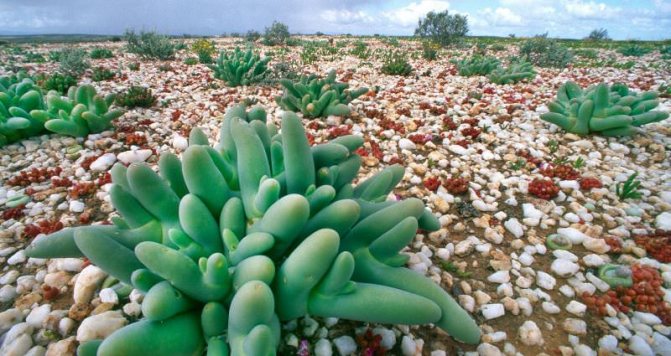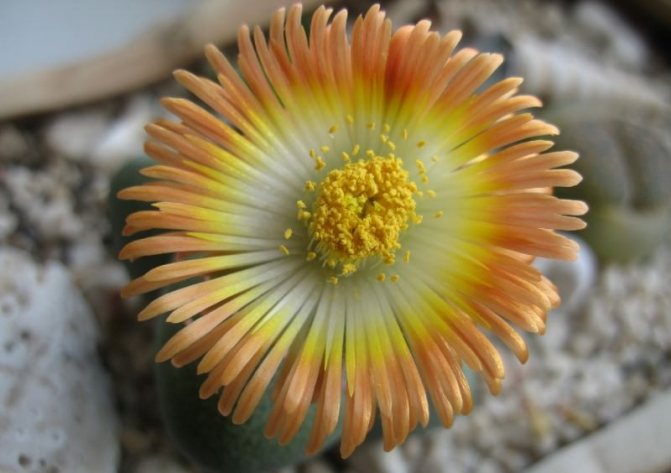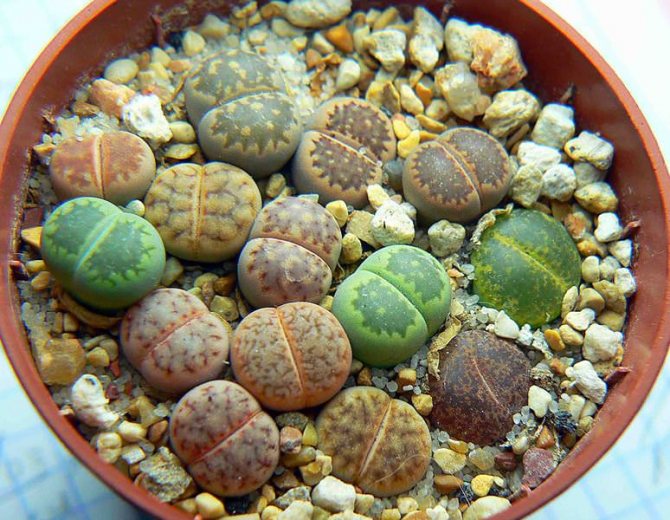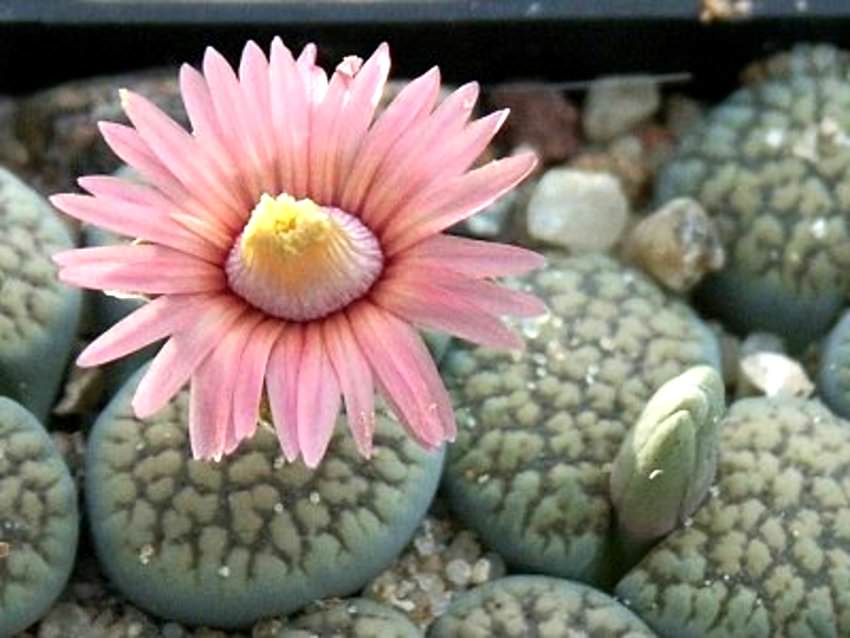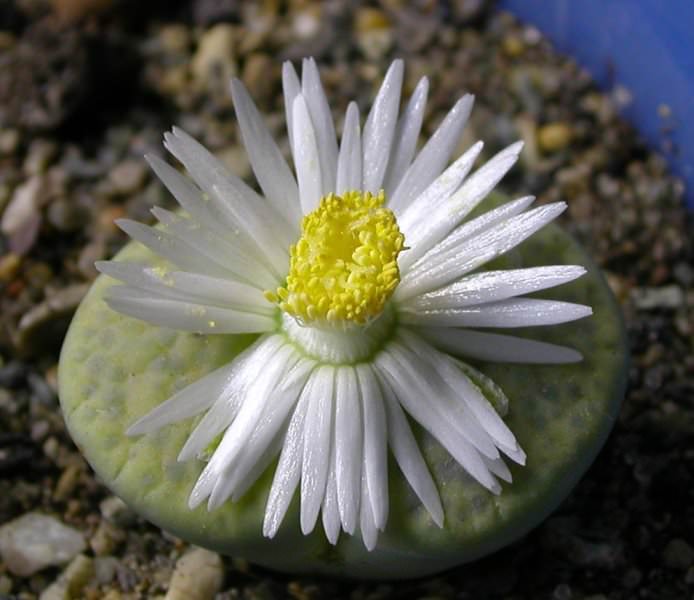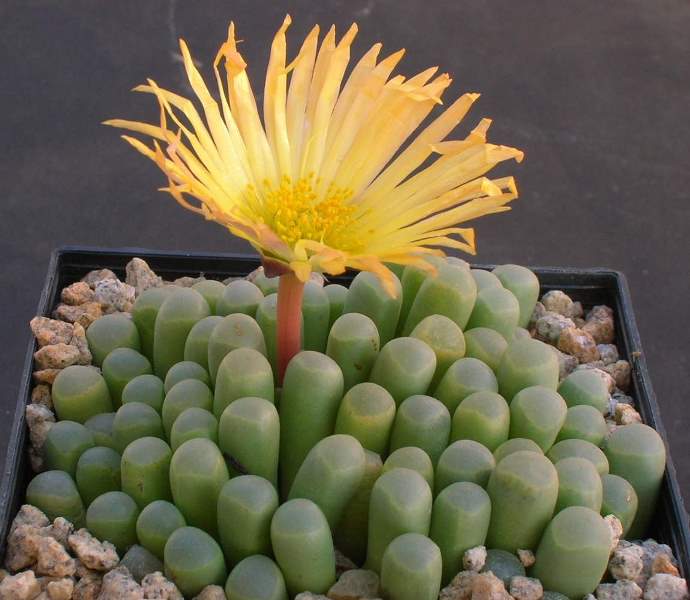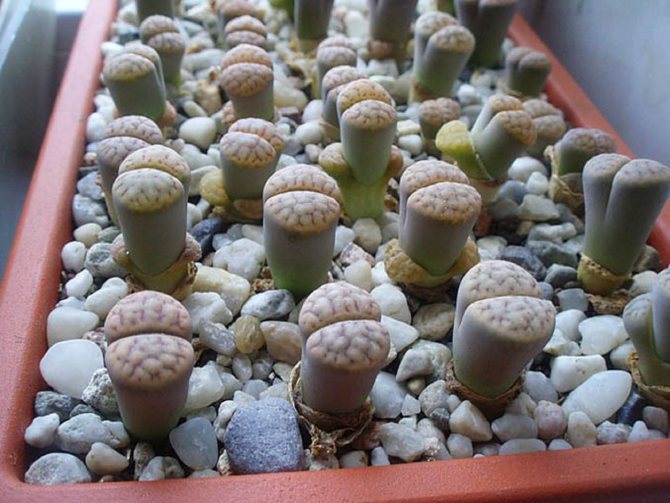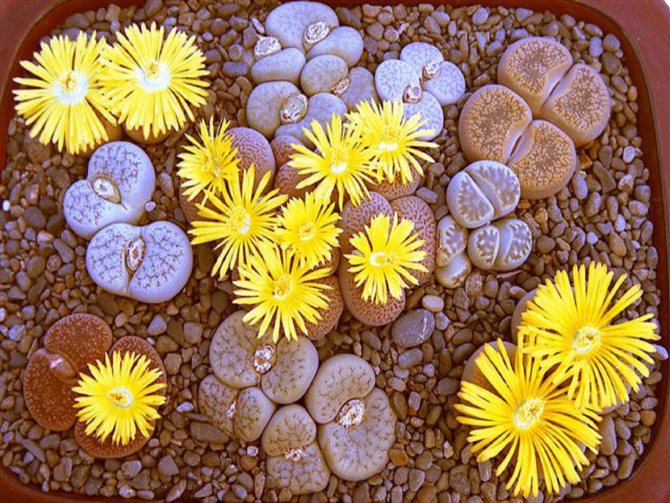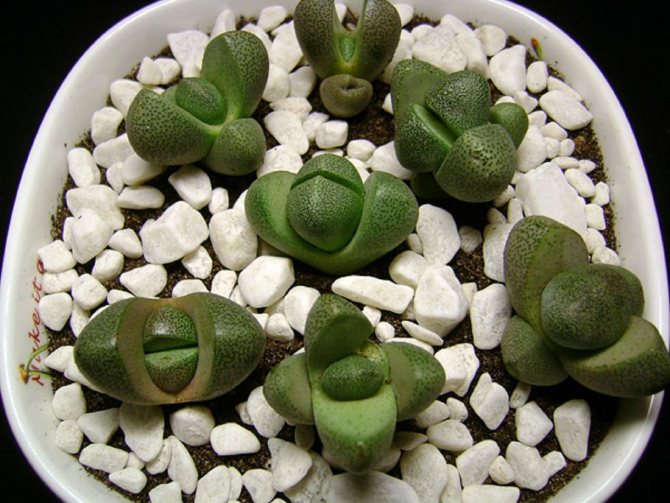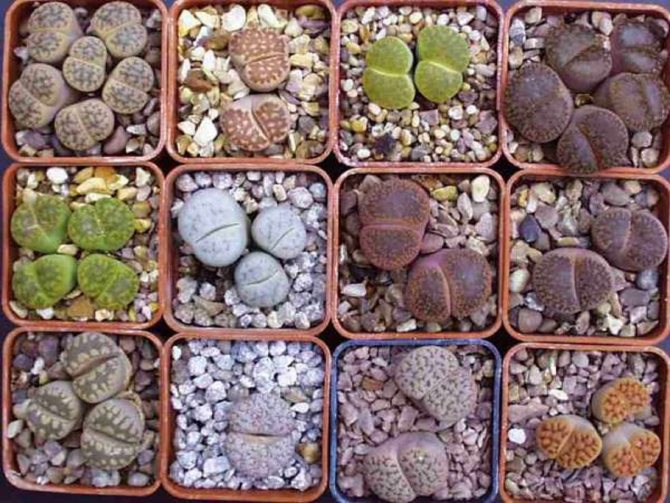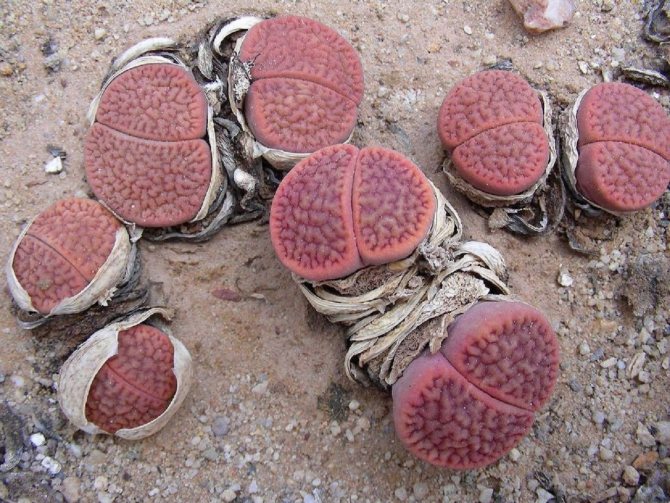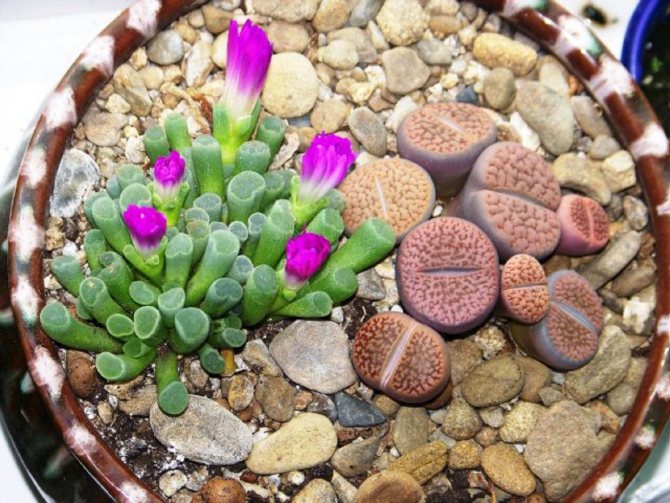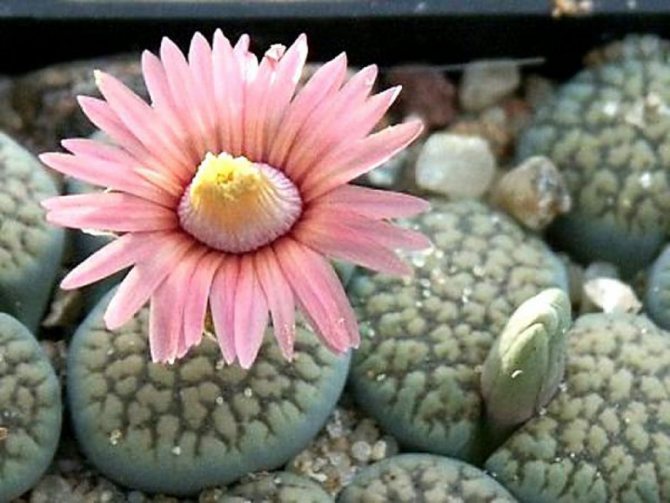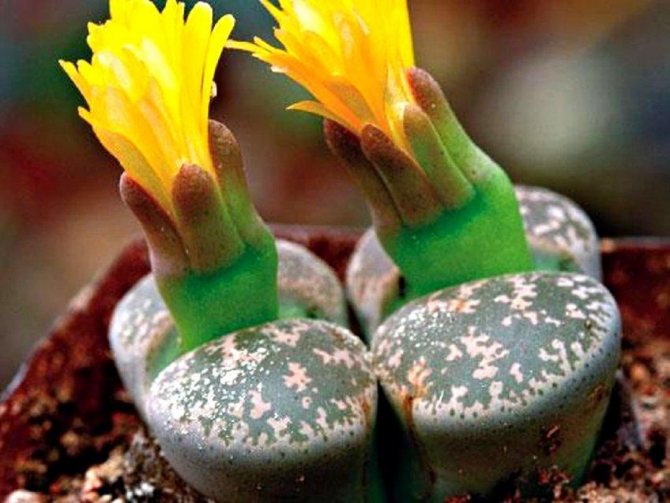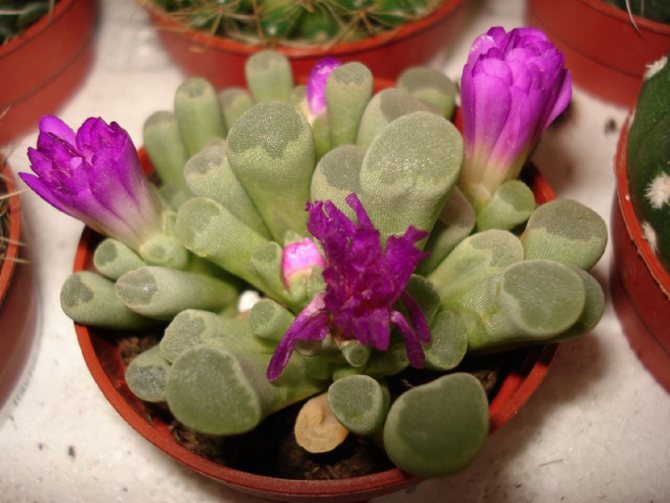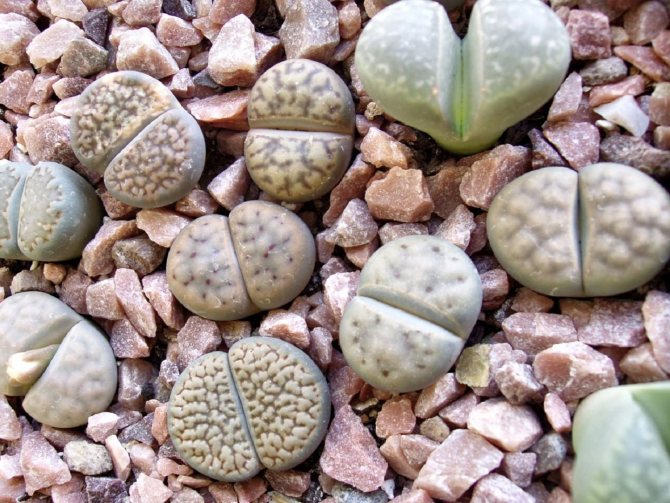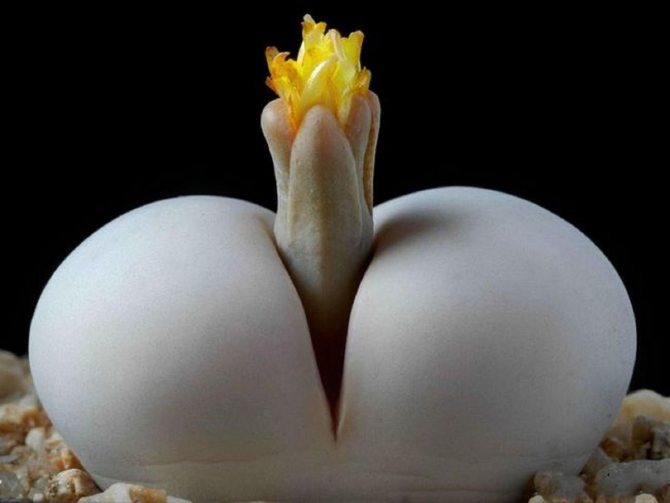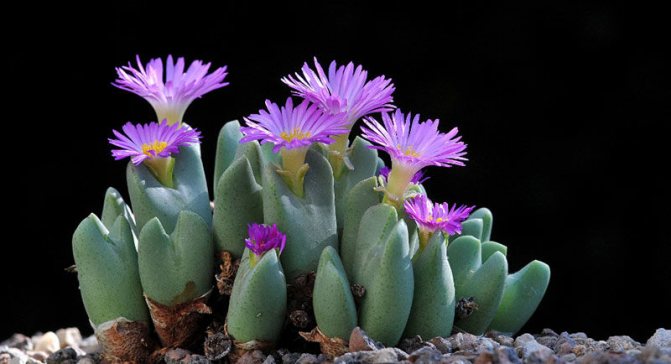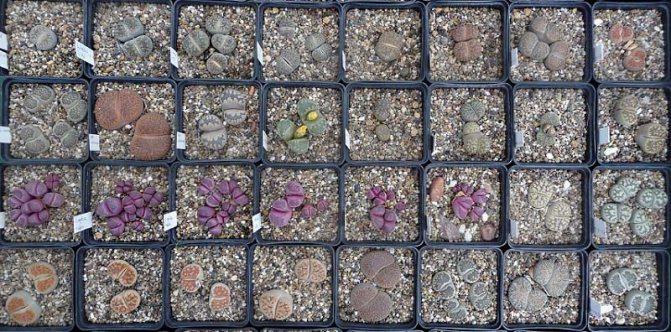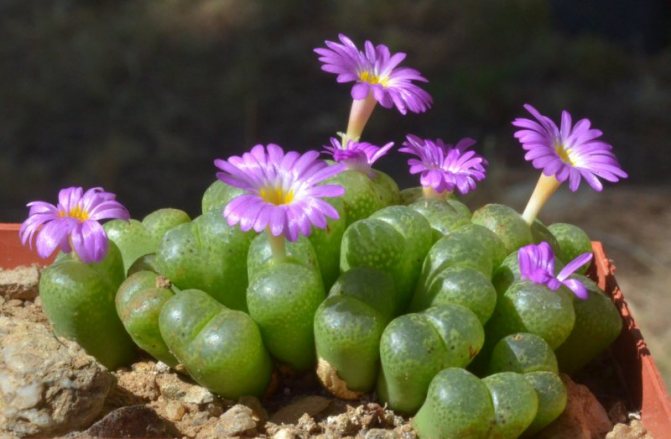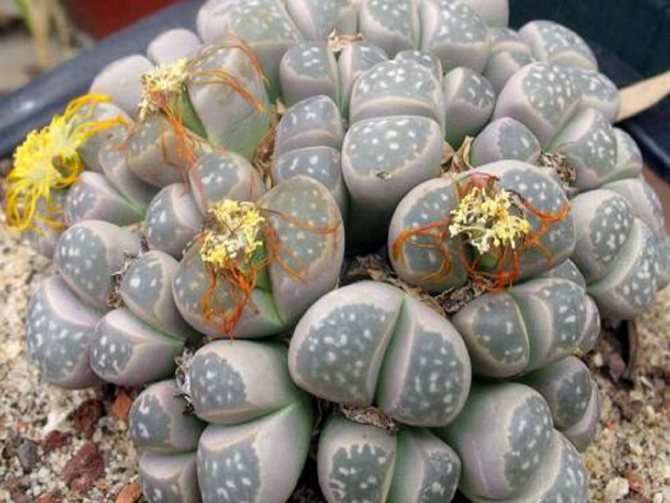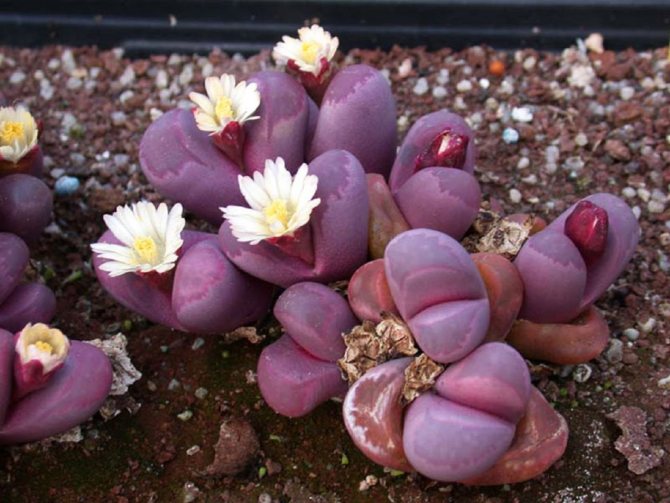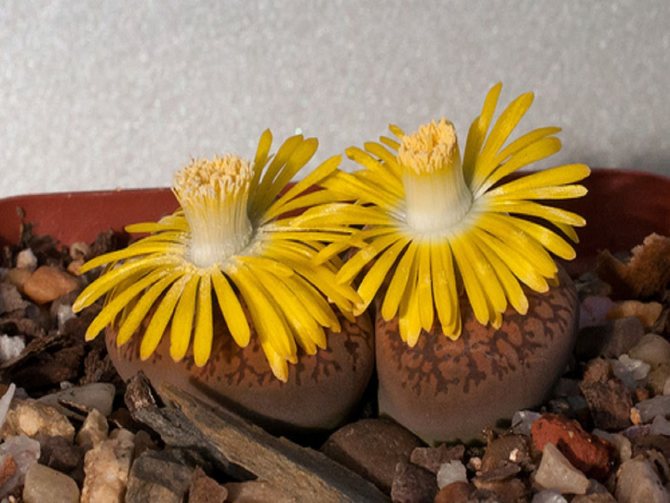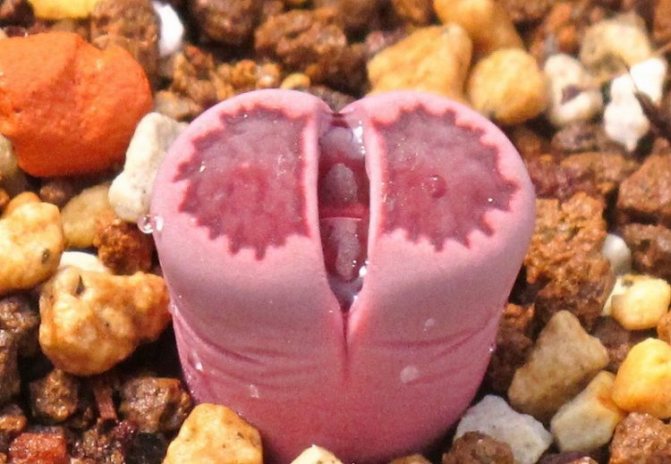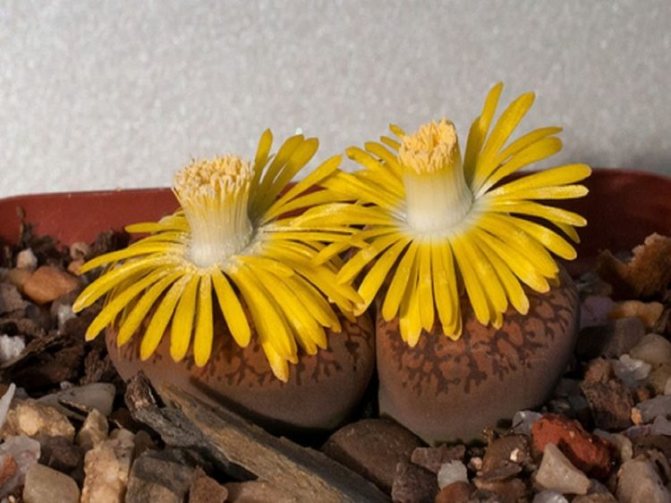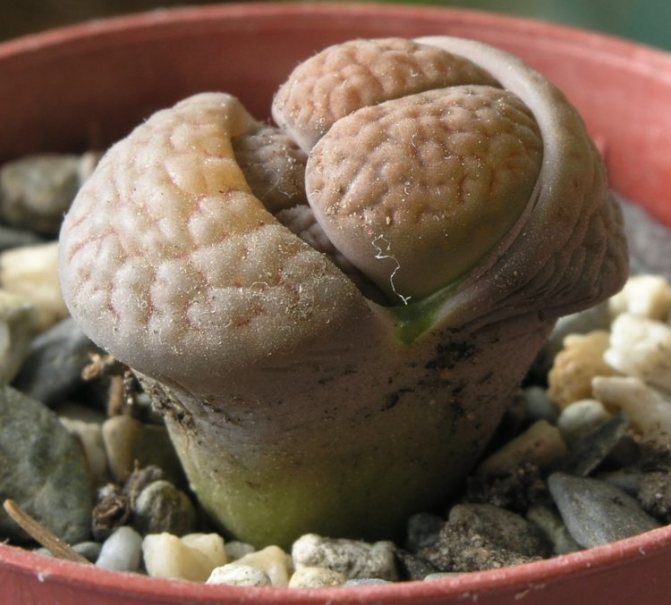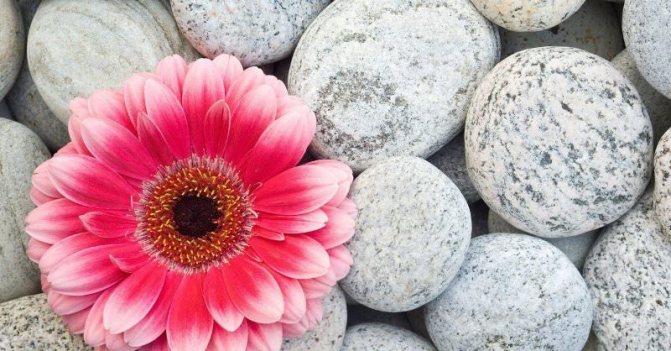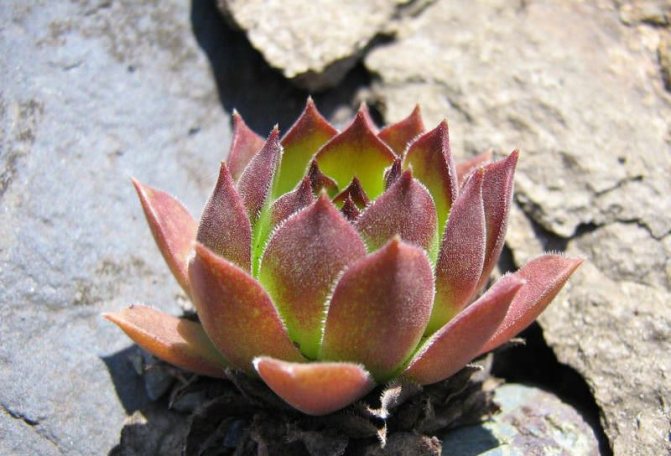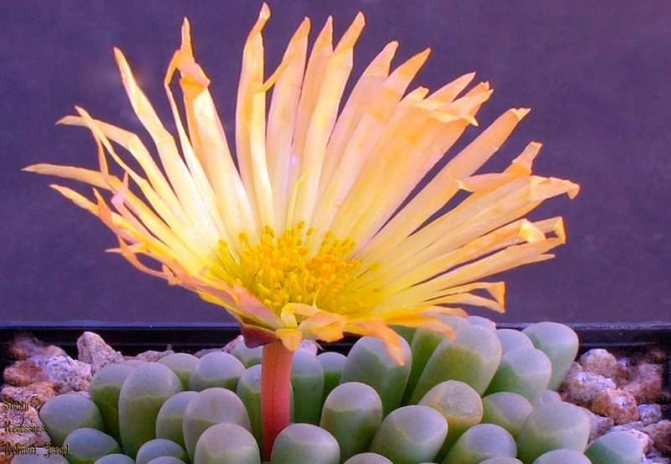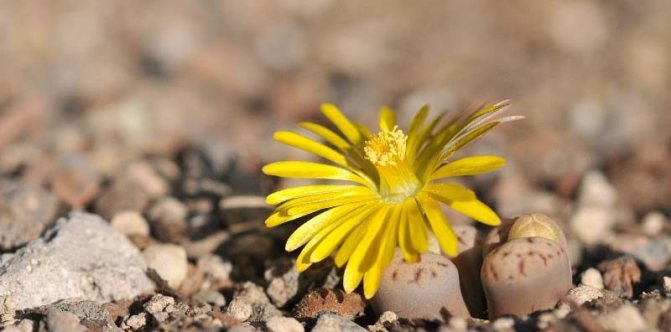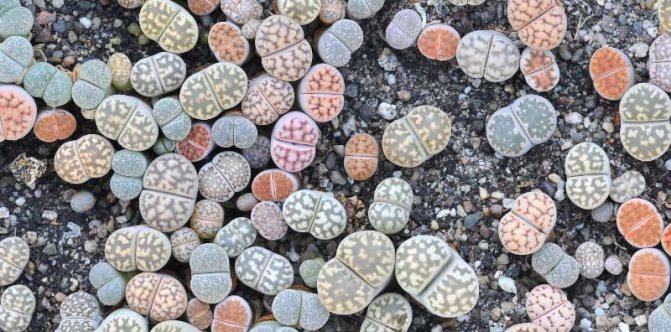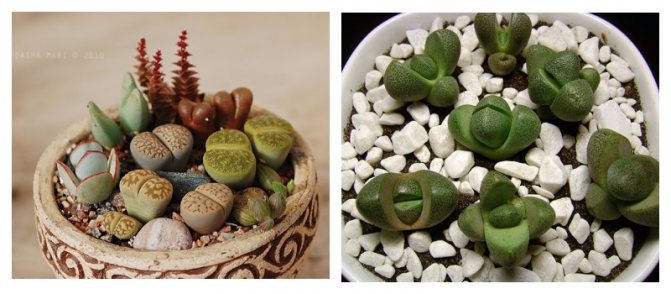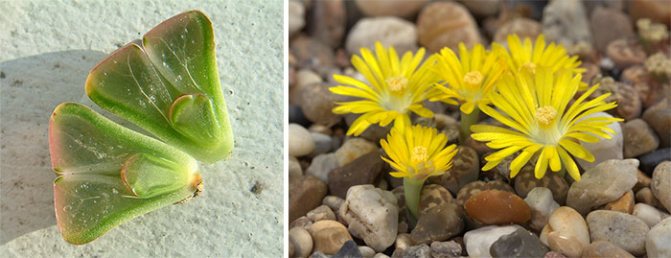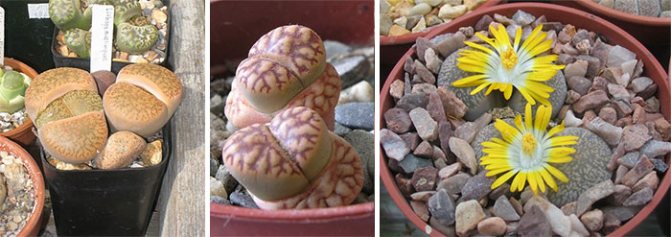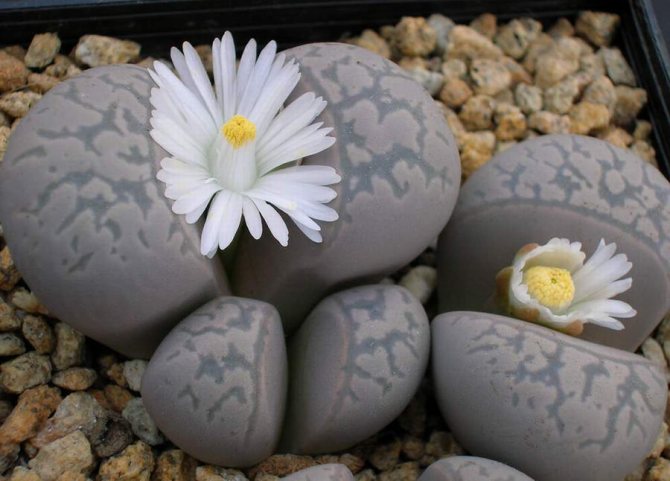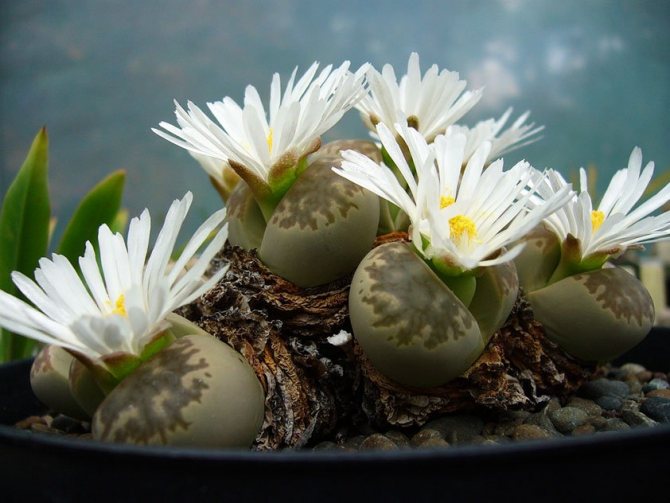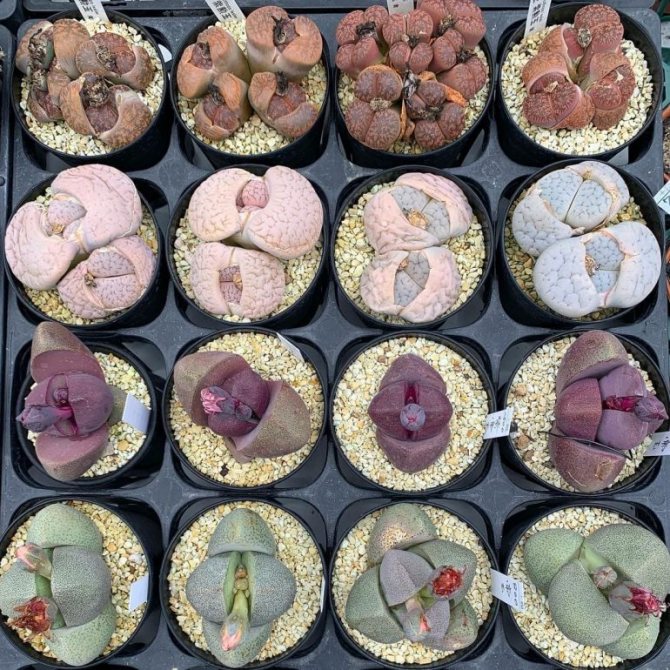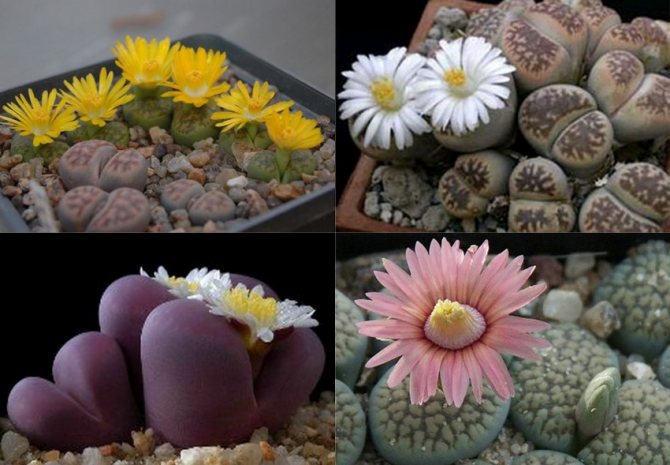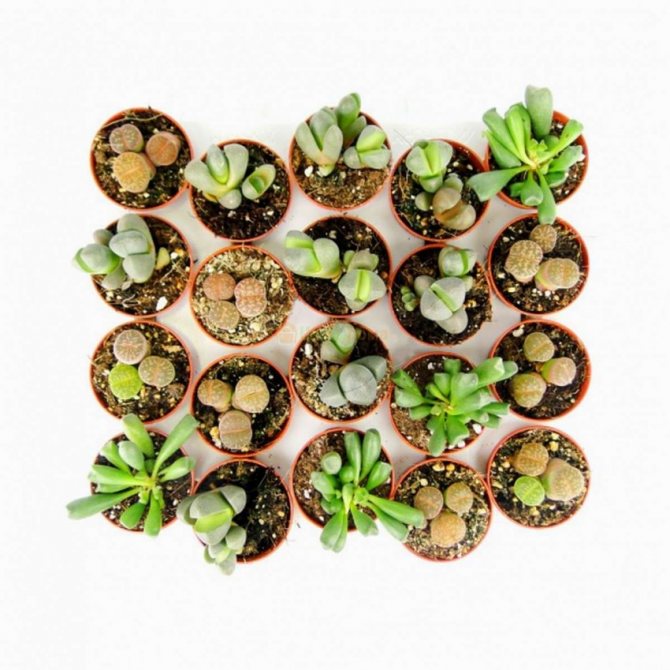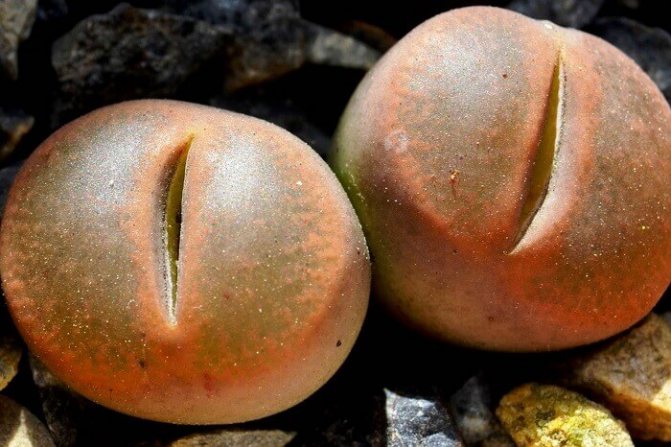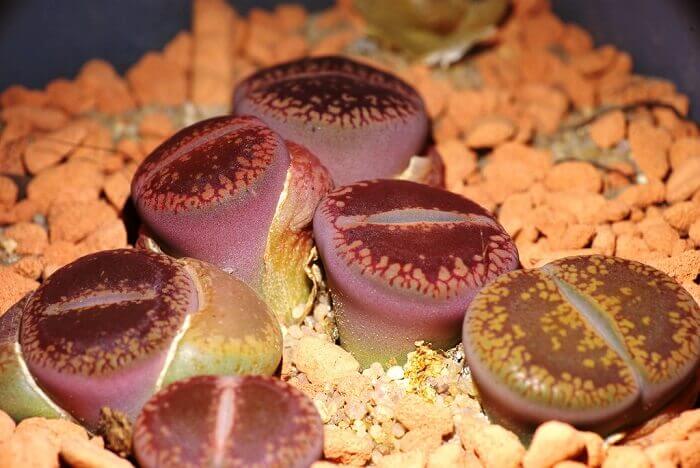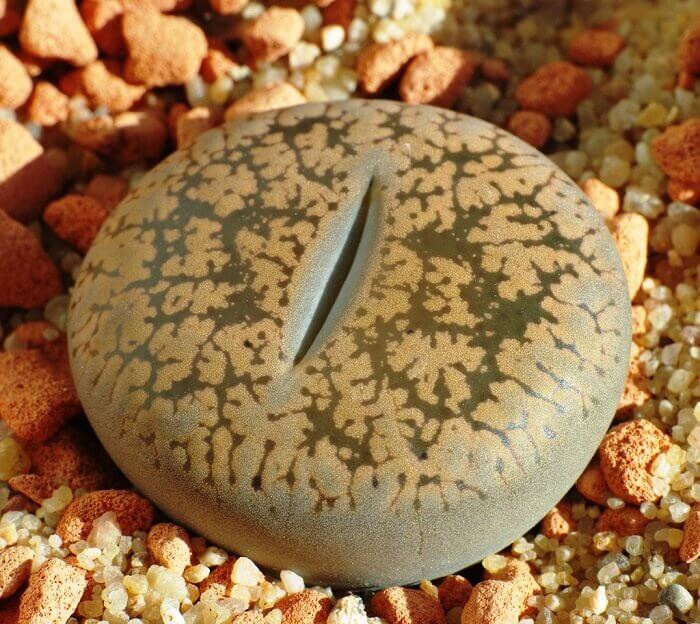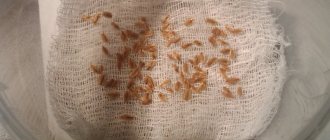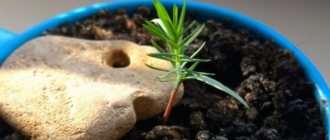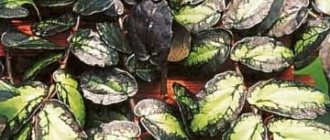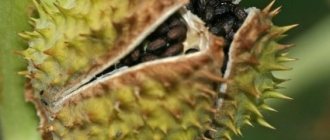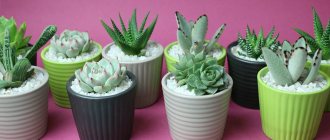Living stones are members of the mesembriantem family, which includes unusual plants from South Africa with rather fleshy leaves and often covered with hairs. A distinctive feature here is that all plants are very diverse in appearance - even those that are grown in rooms.
Speaking of "living stones", we can rightfully call them a clear example of mimicry, because the shape of the plant exactly resembles in appearance the well-known pebbles and very small pebbles, among which it grows in suitable conditions. The ability to "copy" in plants of this type is quite high that even some animals using live stones as food are not always able to find them.
Plant survival possibilities
With all this, living stones have a rather powerful taproot that goes deep into the ground and is able to extract moisture directly from the deep layers of the soil and even among rocks and crevices. However, it should be noted here that during periods of drought, this property does not help the plant, and therefore its aboveground part dies off. Although, in theory, one has only to pass through the rain, so immediately "living stones" are restored.
By themselves, living stones in appearance are two rather thick sheets, which have definitely grown together. Being in natural conditions, "living stones" grow in such a way that only the flattened upper parts of the leaves, sprinkled with sand, are visible. All this can sometimes resemble chamomile or daisies.
Bloom
Florists are attracted by the shape of lithops (they look like pebbles). The upper part of the plant is split into two unequal parts. With proper care, a bud will grow from a smaller part. The buds bloom in white, cream, orange flowers. If you keep them in the sun for a long time, then the petals can change color, fade.
Flowering most often occurs in the fall, from September to October. Sometimes a blossoming flower covers the whole plant with petals. Mostly mature plants bloom. During the flowering of lithops, it is necessary to reduce watering or replace it with spraying.
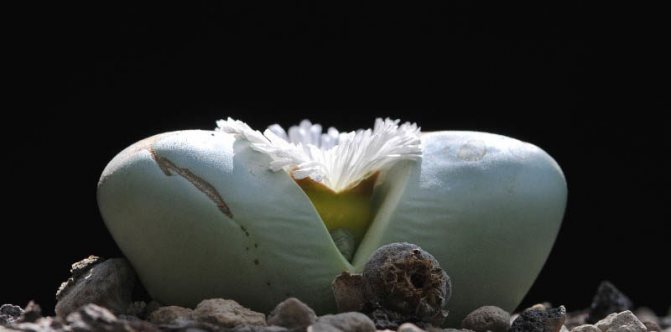
The appearance of living stones
It must also be said that indoor plant growing in general quite often includes plants such as lithops, gibeums, and conophytums. An interesting feature is the fact that one hundred percent recognition of "living stones" is possible only during the period of their flowering. At the same time, in Lithops, the cleft between the leaves is very pronounced at this moment. The pattern on the flattened surface of the leaves is, again, different from species to species. "Living stones" in this case can be from three to four centimeters in diameter. Conophytums, in turn, have a cut in the form of a small dent, from which, in fact, the peduncle emerges.
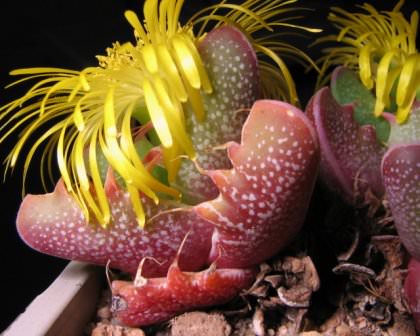

Mesembriantemic plants, in turn, have annual cycles of development, which remain practically unchanged from year to year. When at rest, this type of plant looks depressed, as it loses a certain part of its leaves and, as a result, acquires a color that cannot be called natural.In particular, having passed the hard way through the exhausting phase, called greenish, a significant part of the globular mesembriantems wrap themselves in a pale-dead appearance.
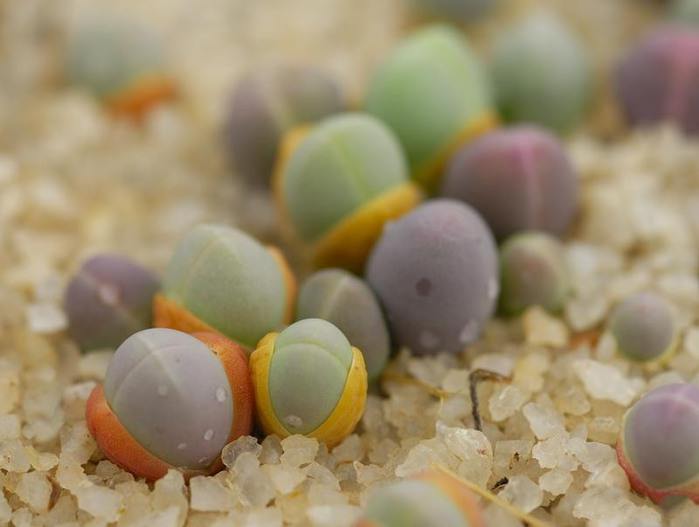

Popular types
There are more than 30 different species of lithops, but it is difficult for non-professionals to distinguish lithops even from plants of another family, for example, from conophytums. Here are some of the most popular types of lithops adapted for home cultivation.
Lithops aucampiae
It has a green and brown color with streaks and streaks.
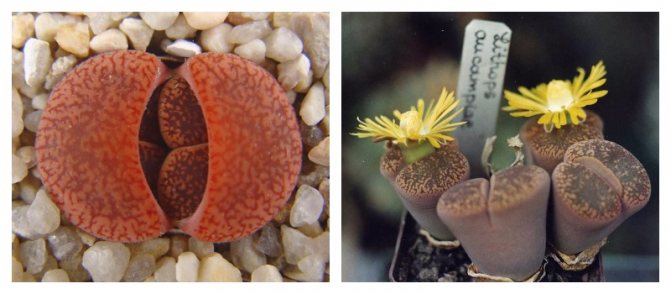

L. Aucamp
Lithops Lesliei
A stone with gray-green leaves, can bloom with yellow or white flowers. This species is very fond of flower growers, perhaps for the reason that it tolerates moist soil well.
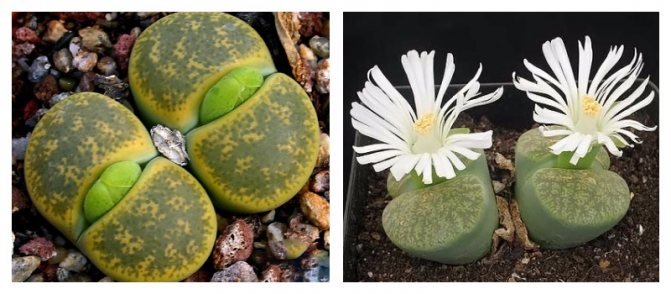

L. Leslie
Lithops marble (Lithops marmorata)
Lithops of this species have a grayish color with marble streaks. Due to its gray color, this plant really resembles a stone.
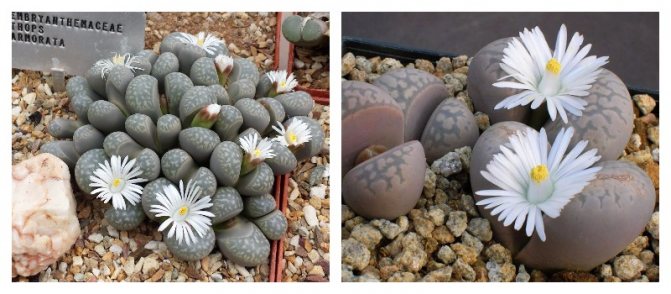

L. Marble
Lithops Optica
These stones grow in the form of tall columns, the gap between the leaf lobes is deep, the color is varied: from gray to bright crimson, the flowers are white.
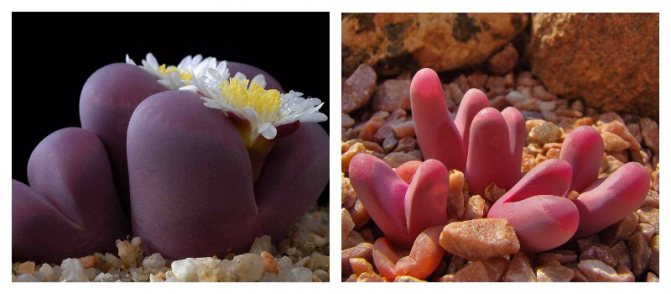

L. Optics
Lithops divergens
The leaves of this plant are deflected from each other, rather than fused together. An adult plant develops a wrinkled leaf structure.
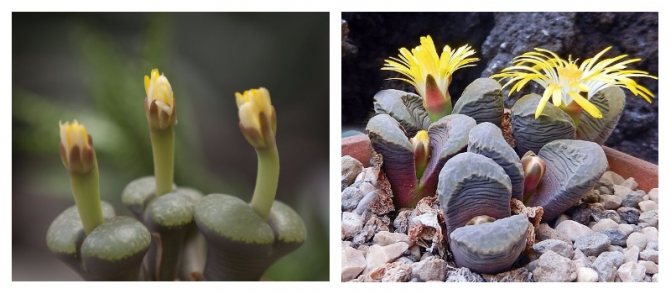

L. Divided
Lithops brownish (Lithops Fulviceps)
On the leaves of this species of succulent there are gray and brown spots, the leaves themselves can also have a brown color.
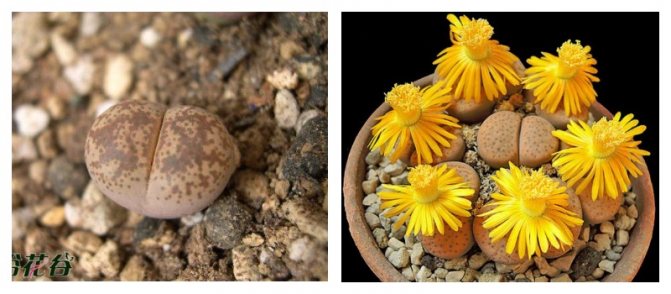

L. Brown
Lithops beautiful (Lithops bella)
Paired leaves reach a diameter of two and a half centimeters. It blooms with white flowers with a delicate aroma.


L. Handsome
Update periods
Other species have a shorter period of redness that lasts for several weeks. Many leafy ones during the dormant period are very clear, stopping in growth. At the very beginning of the growing season, which happens in autumn, the plants renew their green color, doing it intensively.
In the case when a new pair of leaves emerges from the stem, it grows very quickly, while later pairs follow it, located in a cruciform path. Then the next pair forms a branch and its likeness, as a result of which flowers and fruits appear.


Old age in this species passes through the stems and roots, and not through leaf pairs or bodies, which are renewed at least once a year. Most of the leaves do not live for more than two years, because after this period they simply wrinkle, eventually turning into a brown skin. As for the stems, on the contrary, they are almost always hardy, gradually becoming larger in length and thickness, without losing strength in this case. As a result, they simply become too thick and lignified, painfully feel the sun's rays and the slightest mechanical damage. However, this state in itself serves as an actual source of youth, because it is precisely during this period that you can safely divide the stem into several segments and root them.
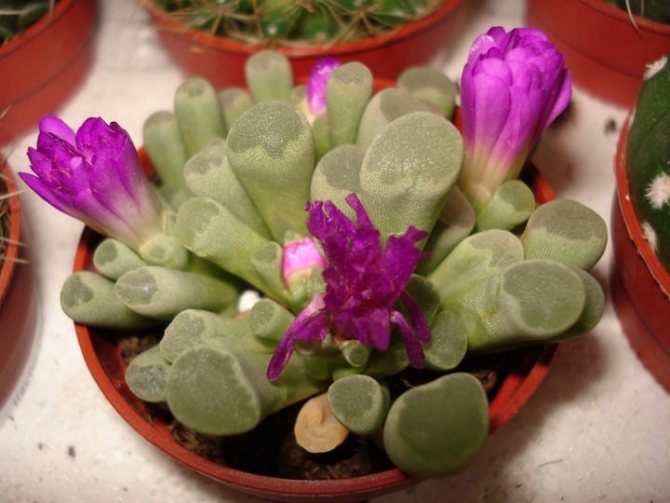

What does a succulent plant and its seeds look like in the photo?
Here you can see a photo of the plant and its seeds:
Caring for "living stones"
Quite often, earthen mixtures are used as a sure means for caring for "living stones". Typically, a standard earth mix consists of two parts of clay-type soil, one part of coarse sand and one part of pumice. There are quite a few options for changing it, while they include such procedures as adding granite chips or perlite, as well as a wide variety of proportions of pumice, sand and clay. The size of pumice particles should be calculated from the principle: the smaller the plant, the smaller the particles themselves should be.In addition, the addition of humus for seedlings is encouraged.
Lithops mix (Latin name.Lithops MIX)
Lithops mix is a planting consisting of several varieties of succulents. Plants are very diverse in color of the leaves and the pattern on them. They look very impressive in compositions consisting both of some lithops and in combination with other succulents.
The photo shows an example of a mix with lithops.
Read also: Janoel 42 incubator automatic: review, description of characteristics and instructions for use
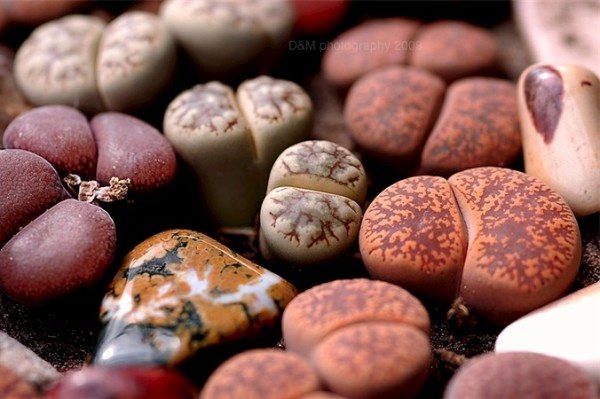

And in these videos you will see all the variety of lithops.
Transplant of mesembriantemic
As a rule, all plants of this family sooner or later outgrow the volume of the pots in which they are located. In this case, a transplant is considered optimal at a frequency of three to four years, or when the first signs of growth inhibition appear. In the process of transplanting, due to salinity (this can occur from the use of fertilizers, unsuitable water, or their prolonged maintenance in unfavorable conditions), it will be very useful to arrange a kind of bath in slightly acidified water for several hours. This approach will make it possible to clean and refresh the roots without any damage. After the transplant is made, the plants should be placed in a dark place for several days. Directly new roots will begin to form literally within one week, but their full recovery may take several weeks, and the plant itself requires close attention throughout the season. However, it is worth noting that the transplant itself can be carried out at any time of the year, while the beginning of the seasonal growing season will be considered the best period for it. Do not bother with transplanting those plants that are preparing for a dormant period, because this can easily lead to outbreaks of sudden activity, which is highly undesirable. We would like to emphasize that "living stones" are best grown in very deep pots.
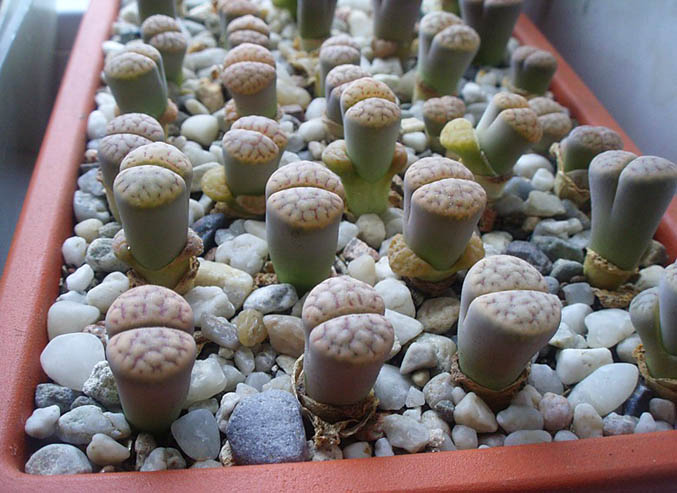

Lithops divided (Latin name lithops divergens)
Divided Lithops got this name because of its appearance. Its leaves do not adjoin closely to each other, like in other varieties, but diverge in different directions, forming a deep crevice.
The leaves are green with small splashes of gray. Their surface is somewhat beveled. Lithops are 1.5-2.5 cm across. The height of the succulent does not exceed 3 cm. In autumn, medium-sized yellow flowers appear from a deep cut.
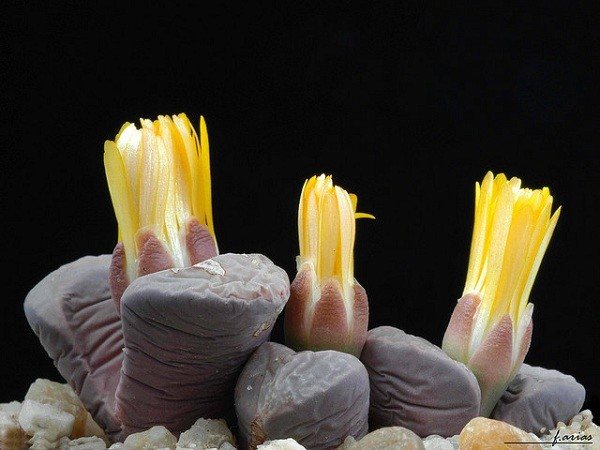

Lighting and temperature for "living stones"
Plants of this type should be kept in a room on a sunny, but at the same time ventilated side, with a window facing south, east or west, which will favorably affect the development of "living stones". Being in the shade will be detrimental to the plant, even if it is in a dormant period. "Living stones" very calmly endure the heat, and in winter they usually require a temperature of about ten to fifteen degrees Celsius above zero.
Lithops Aucamp (Latin name Lithops Aucampiae)
Lithops Aucamp is a succulent cultivar named after Juanita Aucamp, a South African amateur biologist who collected various species of lithops.
The leaf lobes grow up to 2-3 cm wide. Lithops has a rounded upper part.
Lithops Aucamp leaves are painted in green, gray-blue or brown tones. On the upper part of the sheet, against the main background, there is a pattern in the form of darker spots in color.
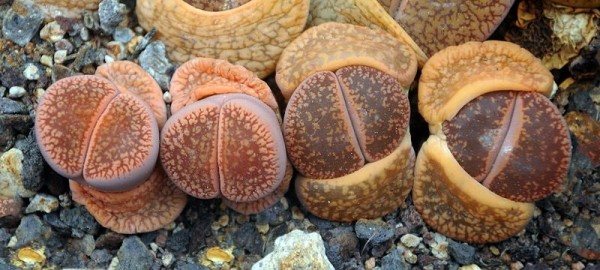

Watering and feeding
It should be noted that the intensity of watering in this case is very dependent on the specific time of the year. After all, "live stones" should be watered much less frequently than most indoor plants - during the active period it is better to do this about once every two to four weeks. Lithops, in turn, are at rest from a later period, because they do not receive water from the end of January to the beginning of May.Just do not let it bother you that the leaves of Lithops begin to wrinkle in winter - neither they nor the conophytums should be watered. After all, this is a completely natural process, and not an indicator of any lack of moisture, which urgently needs to be replenished. During their growth, about once every three weeks, the plants should be fed with a special fertilizer designed for cacti. Land for all the same cacti will also do, since it is freely sold in the appropriate stores. At the same time, another twenty percent of coarse quartz sand must be added here.
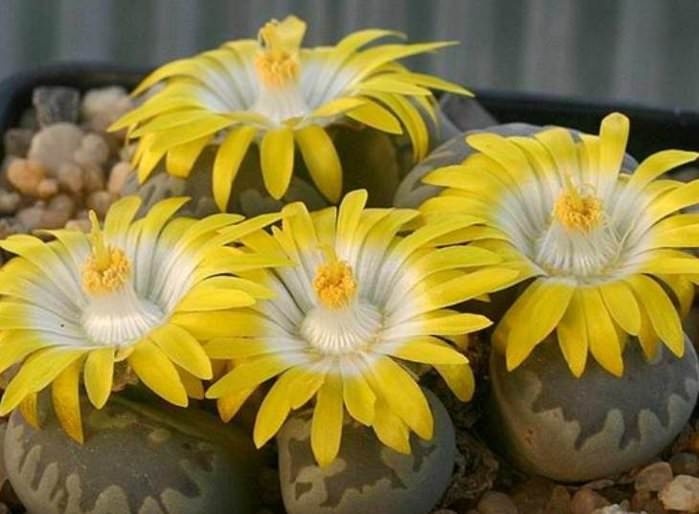

Types of lithops to create a mix
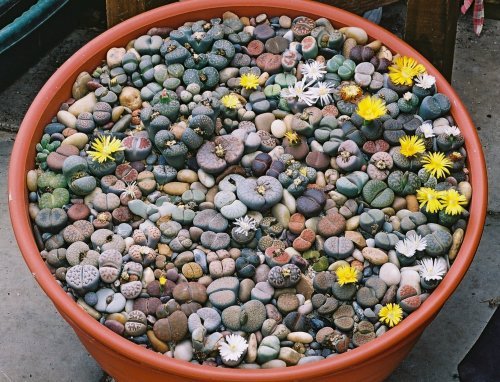

In the natural environment, there are about 40 varieties of lithops. At home, no more than 10-15 types of succulents are cultivated. Among them there are both natural species and bred hybrids.
Some varieties have their own characteristic features, other varieties of Lithops are very similar in shape and color, and only a specialist can determine the species of the plant.
Consider the varieties of lithops, species from the photo.
Reproduction of living stones
Plants of this type reproduce quite easily by seeds. For full reproduction, special cuvettes are needed, as well as sterile and silica-rich soil intended for sowing. Quartz sand is also used here. The flat ditch is filled with earth, in which the seeds are evenly scattered. Then they are slightly pressed and covered with coarse quartz sand to prevent drying out. In the future, all this is carefully moistened, with the obligatory prevention of drying out - this is done until the moment the seedlings appear. For the first two to three weeks, a film covering will create just ideal conditions for the seeds to grow fully. And the best time for sowing is the period from March to June. All seeds are considered extremely small, and therefore they need to be scattered only over the surface, slightly covering them with sand on top. With this approach, sprouts will appear in just a few days. It should take about three years for the sprouts to bloom for the first time.
Diseases and pests
In winter, lithops can be attacked by mealybugs. You can get rid of them by wiping the leaves with a gruel of garlic, soap and water.
If the plant leaves become lethargic, it may need to be watered. However, most often lithops suffer from an excess of water. Watch out for watering, do not let the roots rot.
Lithops remain an outlandish plant even for exotic plant lovers. However, even a novice florist can grow "living stones".
Lithops from seeds at home
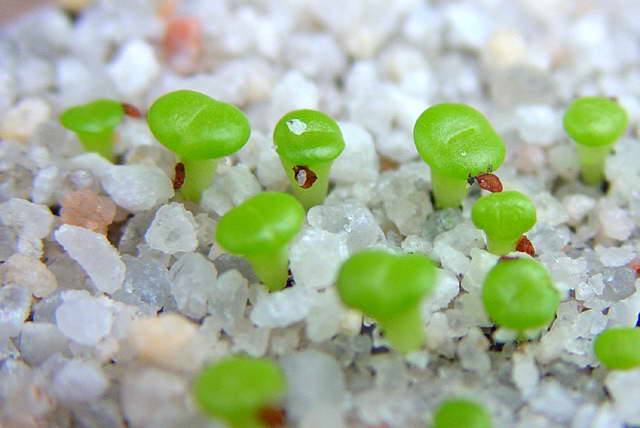

How to grow lithops from seeds Growing lithops from seeds Photo of seedlings
The propagation of Lithops by seeds is quite simple. It is better to immediately purchase a bag of the mixture - then you will get many different types at the same time.
- Sowing is carried out in a wide, shallow dish with a transparent lid and drainage holes.
- The soil mixture for sowing is prepared from standard store soil, sand, perlite (1: 2: 2).
- The soil is thoroughly moistened and seeds are distributed over the surface as rarely as possible. Sprinkle thinly with sand on top, cover the container with a lid or glass, cling film.
- Seeds do not lose their qualities for a long time, so the germination rate can be 100%. They germinate unevenly. The first ones may appear during the first week.
- To accustom small plants to air and for ventilation, the lid on the container is raised every day.
- Watering is carried out through a pan - water is poured into it and drained after a while.
- Pebbles grow very slowly. Sometimes they fall on their side, since the roots are not yet sufficiently developed - in this case, we help them to take a vertical position with a toothpick, pressing them a little into the ground.
- It is better if the container with seedlings is placed in a sunny place.
The first flowering under optimal conditions can occur 3 years after sowing. Living stones grow very slowly - this can be used to create mini-compositions that will remain in their original form for several years. Lithops literally emit positive energy that people in the room feel.
When properly planted, they require almost no maintenance - you can forget about them for several weeks. And "pebbles" will only be grateful to you for this, because they do not like excessive attention. Such a composition is ideal for people who cannot devote enough of their time to caring for indoor plants, but want to have a living corner at home. Lithops will perfectly cope with this task, creating a piece of the unique landscape of the sultry desert in the house.
How to care for lithops
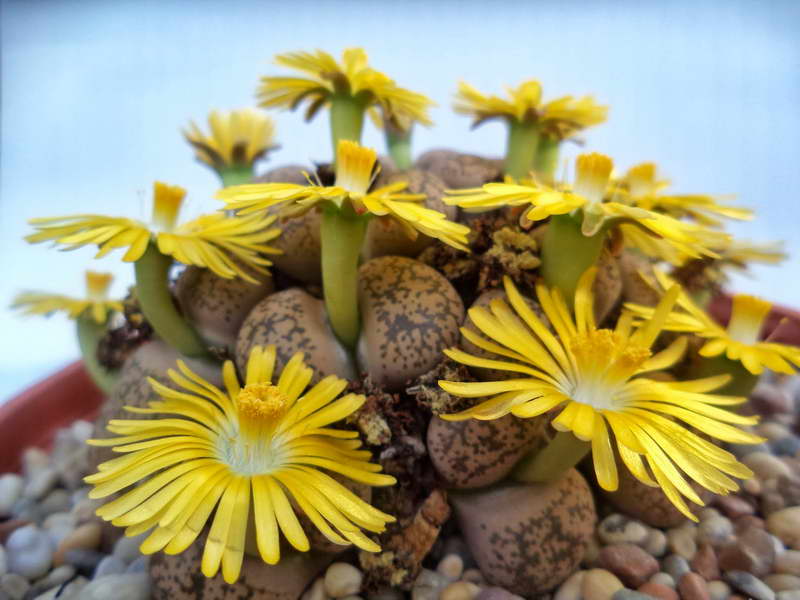

Living stones lithops how to care for succulents at home Reproduction by seeds Photo of flowers
In order to avoid mistakes when keeping lithops, one should understand the cyclical nature and conditions of its growth at home. Live stones are often sold, and the only reason for the low prevalence of these interesting plants is a poor knowledge of their biology and, as a result, improper care, which leads to their death.
It is a very decorative but also extremely sensitive plant. They peek out from under the sandy ground to get their share of the sunlight. These small succulents are extremely varied in color. The top of the leaves is spotty and can be dark red-brown or yellowish, orange, blueberry, dark purple.
Spots, lines and streaks on the surface are a kind of windows through which the plant covered with sand absorbs weak light. With the onset of spring, a pair of new leaves appears from the gap, which replaces the old ones, which have given their strength to resume growth.
- Lithops feels great on light windowsills, reacts positively to airing.
- He needs direct sunlight or artificial lighting for 12 hours every day for 4 hours.
- In low light, the plant may die.
- In winter, it is worth keeping the temperature at 10-15 degrees. Since December, watering is completely stopped, resuming it in March. Lithops can be sprayed only occasionally. Its life cycle ends - it consumes moisture from dying leaves.
- Watering begins in the spring, when a new life cycle begins, resulting in new leaves.
The best way to water is to put water in a pan and after 10 minutes pour out the rest. Or place the container in a bowl with moist peat, which is periodically moistened. At the end of our summer, the life of the lithops stops again - watering should be stopped. In September, lithops bloom, after which watering is again reduced. During the growing period, you can put the container with "pebbles" outside under a canopy to prevent the ingress of rain drops.
Leaving for a dormant period, it ceases to develop, and its leaves fade. Having noticed these signs, it is worth stopping watering and placing the pots in a bright, cool place.
Twice a year, you can fertilize with complex fertilizer, which should be added to the water for irrigation in minimal quantities. This should only be done for plants that have not been transplanted for more than 2 years.
Growing and care
To plant lithops, you need to choose the right pot. Since the plant has a highly developed root system, it must be sufficiently voluminous and deep. A thick layer of drainage material must be poured onto the bottom of the container. Florists claim that lithops develop more actively in group plantings. The soil for them must contain the following components:
- clay;
- small pieces of red brick;
- coarse river sand;
- leaf humus.
After planting, it is worth laying out a layer of small pebbles on the surface.
Lithops prefer bright rooms. They are not afraid of direct sunlight. Living stones do not react well to a change of place and even a turn of the pot. After such actions, the plant may get sick.
The air temperature should be moderate, not more than + 27 ° C. For the summer, it is good to take out the pot of flowers to fresh air, but how to protect it from drafts and precipitation. Wintering must be cool (+ 10 ... + 12 ° C).
Succulents do not need high air humidity, but occasionally spraying water from a spray bottle nearby is useful. It is important to do this at a short distance so that drops of water do not fall on the delicate leaves.
Lithops should be watered in moderation and monitored for dormancy and active growth. The water should not come into contact with the ground parts of the plant. Excess liquid must be immediately poured out of the pot. Ascending watering is preferred. It is important to thoroughly dry the soil between irrigations.
Lithops are able to survive even on poor soils, so they do not need fertilizers. Excess fertilizing can only harm the plant. Instead, it is more beneficial to renew the potting soil more often (every 1-2 years).
With the correct watering regime, lithops do not suffer from diseases. If rot has damaged the plant, it is practically impossible to save it. During the wintering period, mealybugs can settle at the roots. To avoid this, at the end of autumn, you need to carry out a preventive treatment with an insecticide.
A perennial plant lithops from the genus of succulents, the Aiz family, is often called a living stone. Grows in the deserts of Africa (South Africa, Botswana, Namibia, Chile). Collectors love it for its variety of colors and unique patterns on the leaves.
The word "lithops" (Lithops) itself has a Greek origin and literally translates as "having the appearance of a stone." For the first time, the plant was introduced to Europe by botany researcher John William Burchel. He met Lithops at the Cape of Good Hope and described it in his catalog of geography, which came out in 1815.
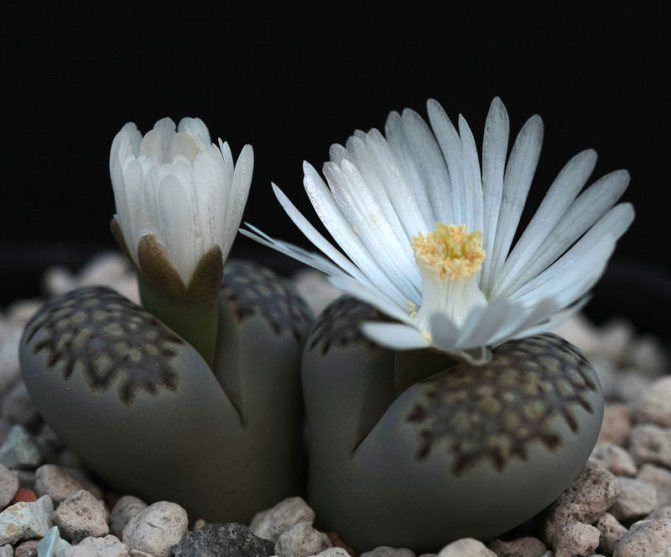

Discovery history
These strange plants are called "living stones". In order not to get anyone's food, lithops are disguised as pebbles.
This species was found in 1811 by the English botanist Burchell, who sat down to rest while traveling in the desert. He found a pile of pebbles next to him. While trying to pick up a pebble, he was surprised to notice its roots. On closer inspection, he saw plants, in color and shape, completely similar to inanimate minerals and having a small size.
Temperature regime
During the growing season in early February and throughout the summer, lithops need a climate with room temperatures. With the onset of winter, lithops begins a dormant period, the temperature must be lowered to 10 degrees in the absence of watering.
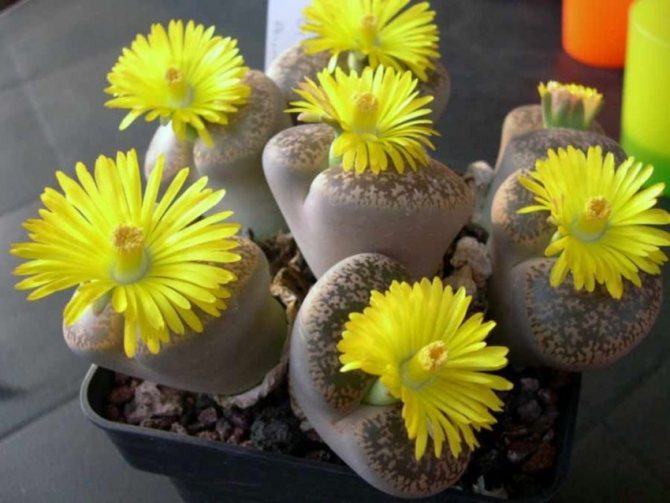

In the summer, it is better to move the pots outside, this is how the plants harden, strengthen them and improve the quality of flowers on lithops.
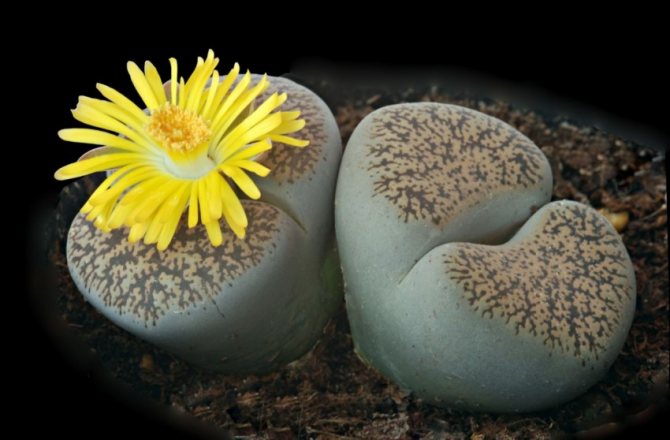

Landing
Lithops should be planted in small pots with a height of 10 cm, because they have a developed root system, which tends to go down as deep as possible.
Note! Too much capacity for a small root system will rot. It is recommended to choose wide bowls, and the soil should pass air and moisture well.
Plants are planted in groups, otherwise "loners" may die. You can combine them in the same pot with other succulents, for example, cacti, or add to the composition in the greenhouse of the schizobasis.
When planting, it is important not to damage a large root, but thin roots grow quickly and soon fill the entire space.
Photo
Plant "living stones":
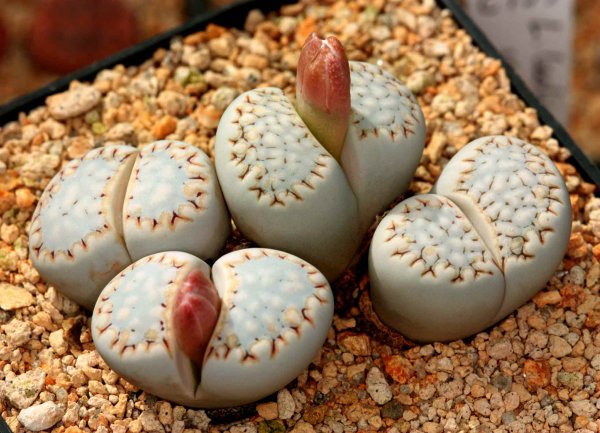

Lithops flower:
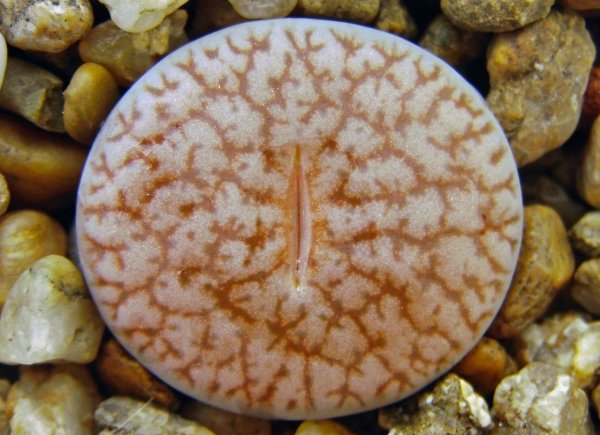

Flower "living stones":
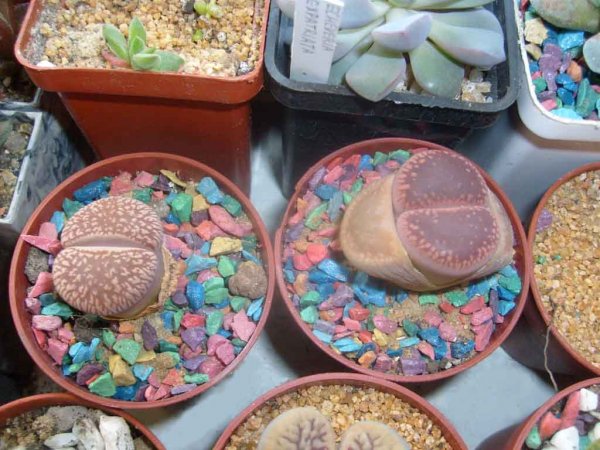

Description of lithops
On the surface of the soil, the plant looks like two fused, falsely truncated fleshy leaves, separated by a narrow groove and similar to smooth small stones or sea pebbles. Lithops have learned to mimic the color and relief of the ground, taking on a color from light green to blue, from beige to brown.
- This tiny plant is no more than 4 cm high and grows up to 5 cm wide. Lithops have no stem.
- The leaves are small, rounded from the sides, flat on top. Their height and width are about the same - up to 5 cm. New shoots and a flowering arrow grow from a crevice between a pair of old leaves.
- Flowers with a diameter of 2.5-3 cm are similar to white, yellow chamomile, in some species orange (red-headed lithops) color. Some have a pronounced odor. The buds open for the first time at noon. Flowering lasts a little over a week.
- The root system of plants is highly developed, several times larger than its aerial part. In severe drought, the roots seem to pull the leaf blades into the soil, thereby saving them and themselves from death.

